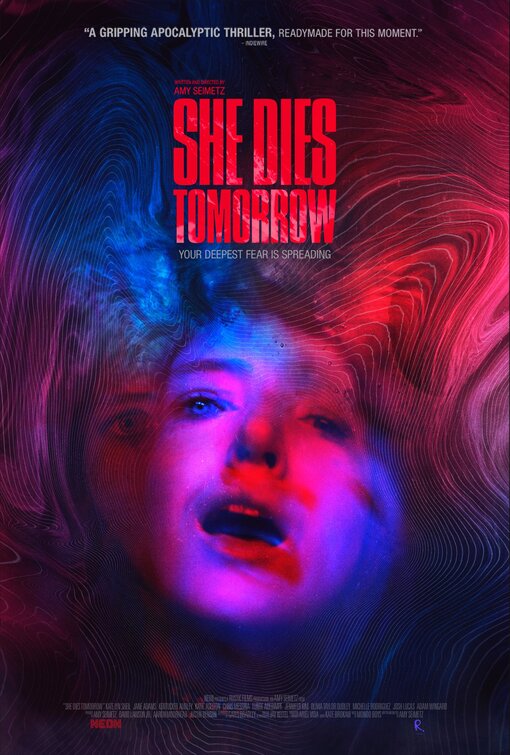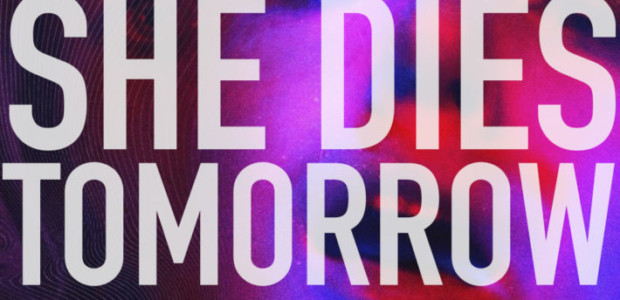Media finds its way to us when it should. SHE DIES TOMORROW, a meditation on the inevitability of death, isolation, and contagion, has found us all in the midst of a global pandemic.
If SHE DIES TOMORROW was released post-vaccine, post-return to normal, it would warrant eye-rolling. Too on the nose to be taken seriously. Since director and writer Amy Seimetz had the good fortune to birth this dreamy little devil just before the world screeched to a halt, it’s eerie and unsettling in a way that proves truth is stranger than fiction. Watch it safely and socially distanced on VOD August 7th, or in select drive-ins, now showing across the States.

Amy (Kate Lyn Sheil) phones her friend Jane (Jane Adams) to say hello, or maybe goodbye, and mentions that, no, she’s not okay. Jane, looking for a reason to avoid her sister-in-law’s birthday party, makes her way to Amy’s new house and finds Amy several bottles in, operating a leaf blower in her backyard. In what Jane assumes is wine-soaked malaise, Amy expresses the desire to be useful in death – like the wooden floors below her, former trees. Their conversation is painful, familiar to anyone who has known an addict. Jane tells Amy, “You are going to die, if you keep relapsing.”
“That’s not what’s happening,” Amy sighs. Later, we see the certainty of death is not the deepest black, or the glowing gold of a light at the end of a tunnel. It’s as bright as a freeze pop: red, blue, teal, purple – and equally cold.
At home, Jane sees the same lights while working, and darts from her home in pajamas to the birthday party she wanted to avoid. “I don’t want to be alone,” she confesses to the other guests. The contact, the conversation, is enough to pass on the inescapable knowledge of death.
Like Amy to Jane, from Jane to beyond, we see each victim begin alone in their new awareness, fixed in a state of blinding grief. Mourning their own lives. The people around them can only look in, hoping to help, maybe a little confused, but there’s no relief to offer. The finality is both inevitable and in plain sight. This impenetrable condition doesn’t falter. If anything, it feels like it gains strength, seeping out further into the world, and each new soul wanting to help before finds themselves in their own stagnant mindset, unreachable in their private sorrow.
The onset of the pain is recognizable to anyone who has suffered from depression or anxiety, and watching it evolve is uncomfortable and necessary. There’s a particular type of self-reflection that comes with that kind of mindset, and it’s fully explored here with a delicate, personal touch. If it’s true that sunlight is the best disinfectant, then Seimetz has created a launch pad for conversations about not only depression, but grief and its processing, at a time when those emotions are impacting us en masse.
The movie feels longer than its 84 minutes, to its credit, in the way that dreams and nightmares have no linear timeline. It makes its way from person to person, in no rush, until it finds a place to stop and rest. The romantic and familiar relationship dynamics are one of the most tangible aspects of the film; Chris Messina and Kate Aselton are especially wonderful as their experiences progress. There are breaks of humor in SHE DIES TOMORROW, and they feel like balloons popping in a silent room: sudden, sharp, and a little scary. They give you a moment to exhale, when you didn’t realize you were holding your breath.
With the evolution of every contamination being deeply personal to each stricken individual, SHE DIES TOMORROW is a transmission chart come to life.
Tags: Aaron Moorhead, Adam Wingard, Amy Seimetz, Ariel Vida, Chris Messina, comedy, Horror, Jane Adams, Jay Keitel, Jennifer Kim, Josh Lucas, Justin Benson, Kate Brokaw, Kate Lyn Sheil, Katie Aselton, Kentucker Audley, Michelle Rodriguez, Mondo Boys, neon, Olivia Taylor Dudley, Suspense, Tunde Adebimpe


No Comments